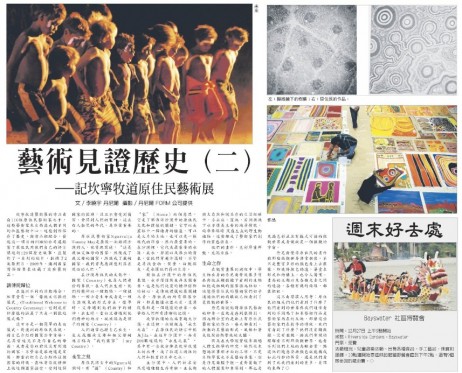 Over the last few weeks we have had a few more pieces of international media around the Canning Stock Route Project and Yiwarra Kuju drawn to our attention.
Over the last few weeks we have had a few more pieces of international media around the Canning Stock Route Project and Yiwarra Kuju drawn to our attention.
After visitng Yiwarra Kuju during CHOGM Christine Mungai wrote an article about the exhibition entitled ‘Aboriginal art exhibition celebrate a living culture and way of life’ for The East African Magazine. Since it has not been published online here is a small excerpt for you:
All around the world, indigenous cultures seemed to follow the same trajectory once they came into contact with European colonisers: Not only did they fall to the invaders’ superior weapons, they were also infected by new diseases against which they had no immunity, decimating the population far more efficiently than the European guns. In the end, once-robust cultures were very nearly wiped out completely.
One notable exception is Africa. Despite suffering outbreaks of diseases like smallpox and rinderpest that devastated both humans and livestock, the African continent was not completely taken over by colonisers the way that North America, South America and Australia were.
For this reason, the Yiwarra Kuju Canning Stock Route exhibition that was on display in Perth, Australia during this year’s Commonwealth Heads of Government Meeting had a particular personal resonance. Yiwarra Kuju means “One Road,” and the exhibition puts together paintings, stories, short films, cultural artefacts, photography and interactive media to tell the story of how a cattle track forged by government surveyor Alfred Canning cut through Aboriginal territory, disrupting traditional cultures and livelihoods.
The story of the Canning Stock Route is reminiscent of the Kenya- Uganda railway line cutting its way from Mombasa to Lake Victoria, meeting fierce resistance on the way, and priming those lands to be settled by Europeans. In the late 19th century, the gold mines of western Australia were facing a beef shortage because cattle had been infested by ticks that causes red fever.
Also Epoch Times have published a second article in Chinese about the exhibition. You can view this article online here.

